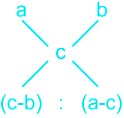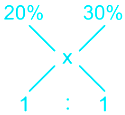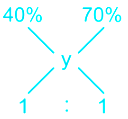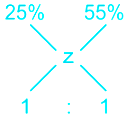Solutions
Given,
Four vessels are filled with mixture of wine, water and cold drink with wine concentration 20%, 30%, 40% and 70% respectively.
Formula:
Mixture and Allegation method:

Where, a > c > b
Calculation:
Let concentration of wine in first two vessels emptied into another vessel be x, then
Using allegation method

According formula
(30 – x)/(x – 20) = 1/1
⇒ 30 – x = x – 20
⇒ x + x = 30 + 20
⇒ 2x = 50
⇒ x = 50/2
∴ x = 25%
Similarly,
Let concentration of wine in last two vessels emptied into another vessel be x, then
Using allegation method

According formula
(70 – y)/(y – 40) = 1/1
⇒ 70 – y = y – 40
⇒ y + y = 70 + 40
⇒ y = 110
⇒ y = 110/2
∴ y = 55%
If 25% and 55% concentration of wine of two vessels emptied into a large vessel,
Let concentration of wine in large vessel be z%, then

According formula
(55 – z)/(z – 25) = 1/1
⇒ 55 – z = z – 25
⇒ z + z = 55 + 25
⇒ 2z = 80
⇒ z = 80/2
∴ z = 40%
Alternate Method
Let capacity of each vessel be 100x
Hence, wine in respective vessels = 20x, 30x, 40x and 70x.
And, total amount = 4 × 100x = 400x
∴ Required concentration = [(20x + 30x + 40x + 70x)/400x] × 100 = (160x/400x) × 100) = 40%



 Get latest Exam Updates
Get latest Exam Updates 





 ×
×






